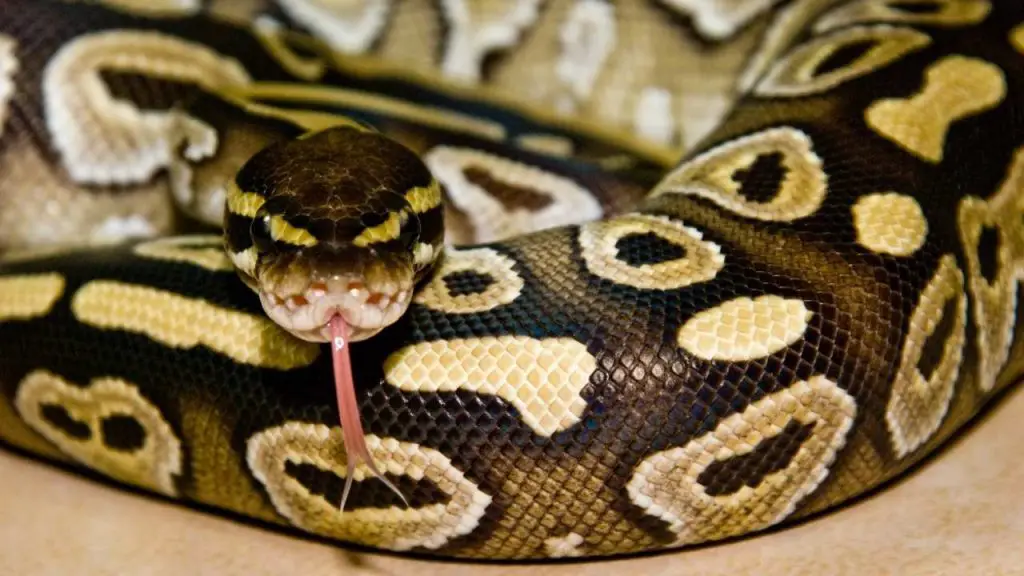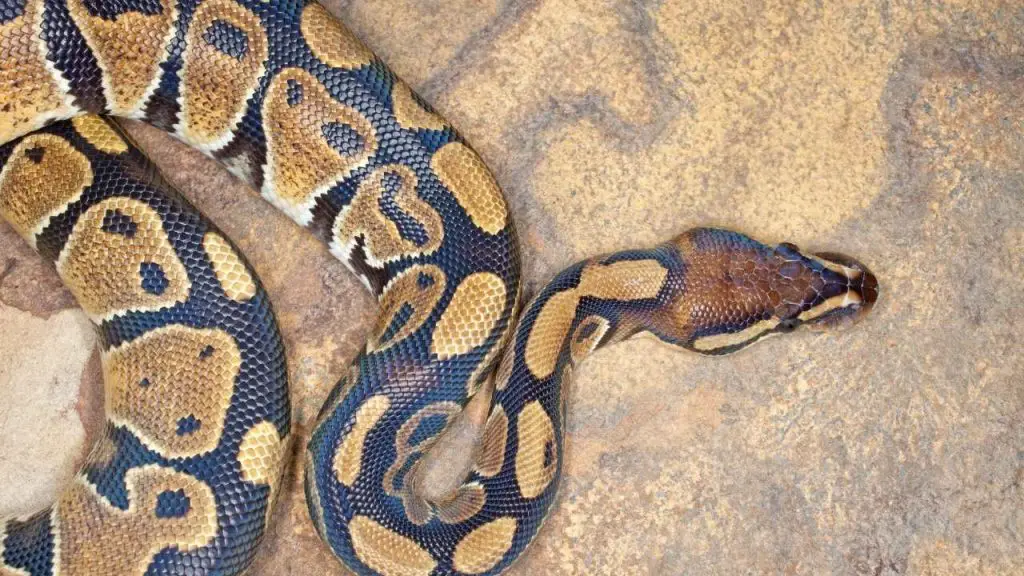Are you just noticing that your snake has a red or pinkish-red line on its belly and wondering why? You’re not alone.
Many long-time ball python breeders only happen to find out this color change after years of being a keeper.
It’s simply because the red or pinkish-red belly coloration only lasts for a few days. That is why it can be easily missed.
The reasons behind the red belly coloration and what to do will be discussed in this article.
In the end, not only will you not worry if your snake has a red belly, but you’ll know what to do.
This article has been reviewed by Dr. Gospel. Read more about our knowledge control process here.
Contents
Why Do Ball Pythons’ Belly Turn Red?

Ball pythons’ belly turns red for four possible reasons.
One of these reasons is a natural and normal occurrence which shouldn’t cause panic.
The factors include shedding, wrong heating (excessive heat), too wet substrate, and allergic reaction to the substrate.
Shedding
It’s normal for the belly of ball pythons to turn red or nearly pinkish-red when they’re about to shed.
This red belly coloration usually occurs a few days or weeks after their shedding.
Many keepers miss this red belly sign because it only lasts for a few days. Hence, it takes a very observant keeper to see this red belly sign on his snake.
I’ve had many long-time ball python keepers express panic when they see the belly of their snake turn red.
The reason most likely is that they didn’t notice it before. Actually, the sign has been there before; perhaps the keeper just missed it.
That said, when you notice the belly of your ball python turning red, your snake is likely to be in its shed.
However, if your snake isn’t in its shed just yet, you have to check for these other factors.
Wrong Heating (Excessive Heat)
If your ball python isn’t about to shed, chances are the heater is excessively hot. When the heater is heating wrongly (that is too hot), it can burn the belly of your snake.
What usually causes excessive heating is having an unregulated heat pad or heat rock in the cage.
Burns also occur as a result of not using a thermostat and a digital thermometer with a remote probe to get the exact temperature of the cage.
Ideally, the temperature in the ball pythons’ cage shouldn’t exceed 95°F.
Using a thermostat with a digital thermometer, it’s easy to keep tabs on the temperature in your snake’s cage.
If shedding and burns from excessive heating are completely ruled out, then check for these other factors.
Lying On Too Wet Substrate
Red belly in your ball python could also mean scale rot or skin infection. This is usually accompanied by blisters or patches of pink or red on the skin.
This type of redness of the belly is caused by a too wet substrate.
When the substrate is too wet, it creates a comfortable environment for bacteria and viruses to thrive.
Once the immune system of your snake is compromised due to attacks by bacteria, it’ll lead to illness.
The belly of your ball python can turn red if you’ve been keeping it on a red-dyed substrate.
Your Snake Is Showing Allergy To Its Substrate
You can only suspect your snake is showing allergy to its substrate if you changed its substrate to a new product you haven’t used before.
This allergy may range from minor red belly discoloration to a serious internal issue.
If you’re sure your ball python’s belly turns red because of its substrate then you have to change it to another type.
For a healthy ball python, we recommend paper towels, Aspen, and Cypress as substrates.
Skin infection (dermatitis)
Skin infection (dermatitis) is the most common reason why a ball python’s belly turns red. The infection can be caused by a number of different things, including:
- Bacteria
- Fungus
- Mites
- Poor husbandry (such as dirty cage conditions or not enough humidity)
If your ball python’s belly is red, it’s important to take him to the vet for a checkup and to get started on treatment as soon as possible. Left untreated, skin infections can lead to serious health problems, including sepsis (a potentially life-threatening condition caused by infection spreading throughout the body).
Treatments For Ball Pythons With Red Belly

From our discussion in the previous sections, you can see that ball pythons’ belly turning red isn’t always a sign of shedding. Sometimes, it’s a sign that something is wrong.
If burns or other factors cause it, here’s what to do. These tips are what you can do when your ball pythons get a red belly without visiting a vet.
- For burns caused by heat pads, check for the cage temperature and ensure it’s kept within the ideal range. Also, check that your thermostat is working perfectly.
If the burn is so severe that it causes blisters and open wounds, soak your snake in a solution of povidone-iodine and water. Do this for 30 minutes every day till the wound is healed.
After soaking your snake each day, you can apply some antibiotics to the affected area. We recommend antibiotics such as betadine ointment, silvadene cream, polysporin, and flamazine cream.
At the same time, provide your snake enough drinking water to ensure it stays hydrated while recovering.
- Red belly for ball pythons is also caused by a wet substrate. In this case, you have to do a thorough cleaning of the entire cage using a reptile disinfectant.
Make sure you clean all cage accessories and dry them properly.
Before putting your snake back in its cage, ensure the substrate is changed.
Also, ensure that the vivarium temperature and humidity are kept at ideal levels.
To avoid re-contaminating the enclosure, soak a clean towel in warm water, and clean your snake very well.
What To Do To Keep Your Ball Pythons Healthy To Avoid Red Belly
Your knowledge of what causes red belly in ball pythons and how to remedy it will give you an edge over other snake owners.
Aside from shedding which is a natural occurrence, other factors are what you should look out for to avoid the issue.
Here are a few tips to ensure that your ball python doesn’t have a red belly:
- Ensure that the cage temperature and humidity are at optimal levels. Check from time to time that your heat pads aren’t emitting too much heat that can cause burns.
- Always use a thermostat, hydrometer, and a digital thermometer with a remote probe to regulate their cage temperature.
- Ensure you provide hides in the cool side of the cage. This will help the snake to cool off when the temperature is too high.
- Ensure that you provide your snake with a heavy water dish. This is to avoid the snake from pouring the water on its beddings.
- If the substrate is too wet, ensure you clean it out and put a new substrate to avoid skin infections. It’s advisable you use a substrate that can retain high humidity such as Cypress Mulch.
- When your snake is in shed, increase the cage humidity to help the snake shed properly. You can soak your snake in warm water if it has any problem shedding its entire skin.
But do not try to remove the skin yourself. This way you may cause serious skin problems to the snake.
Fully understanding your ball python will help you better take care of them. As a suggestion, we would recommend you to get a good ball python book. Not to become an expert on ball python care but will help you avoid the common mistake in new pet snake owners.
Last update on 2022-12-29 / Affiliate links / Images from Amazon Product Advertising API
When Do You Need A Vet?
You’ll need to take your ball python to a vet if it does not only show red belly signs.
Other symptoms that may come with the red belly discoloration include scale rot, loss of appetite, overall dull body-color, dry and wrinkled skin, milky or bluish or opaque eyes, and lethargy.
Each of these other symptoms suggests something internally or externally wrong with your snake.
As a result, it’ll need to be correctly diagnosed by a certified vet for proper treatment.
Wrapping Up
If you know your ball python well enough and can tell when it’s in shed, there’s little to worry about its belly turning red.
This means that if your snake is about to shed, its belly is likely going to turn red for some time.
This will disappear on its own once the snake is done shedding. But if you’re sure your snake isn’t in shed, then you need to worry about its health.
Your ball python can get burnt by an unregulated heat pad. Its belly can also turn red because of its beddings.
Whatever is the cause, this article has provided you with tips on how to treat your snake if it got burned.
Besides, to keep your ball python healthy and avoid red belly, you must follow the tips in this article.
As a rule of thumb, ensure that your snake’s habitat and husbandry is good.


Thank you very helpful , informative . Took away my panic.